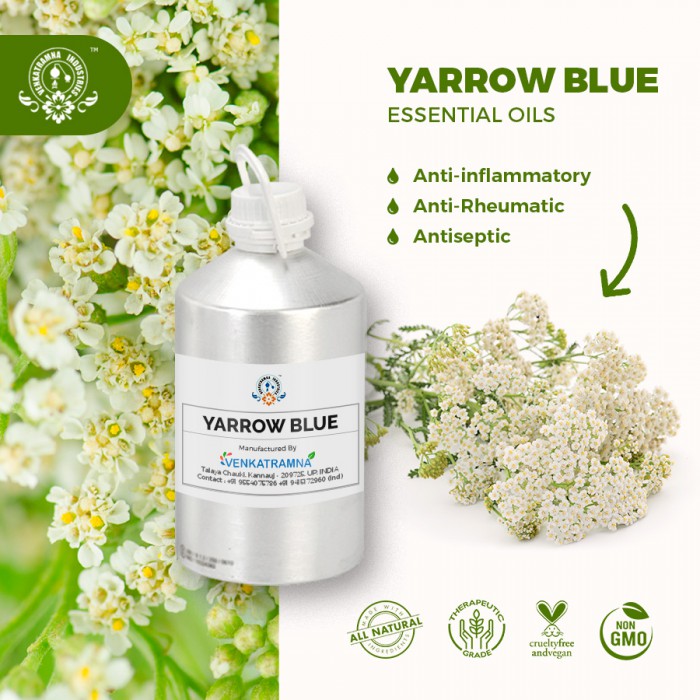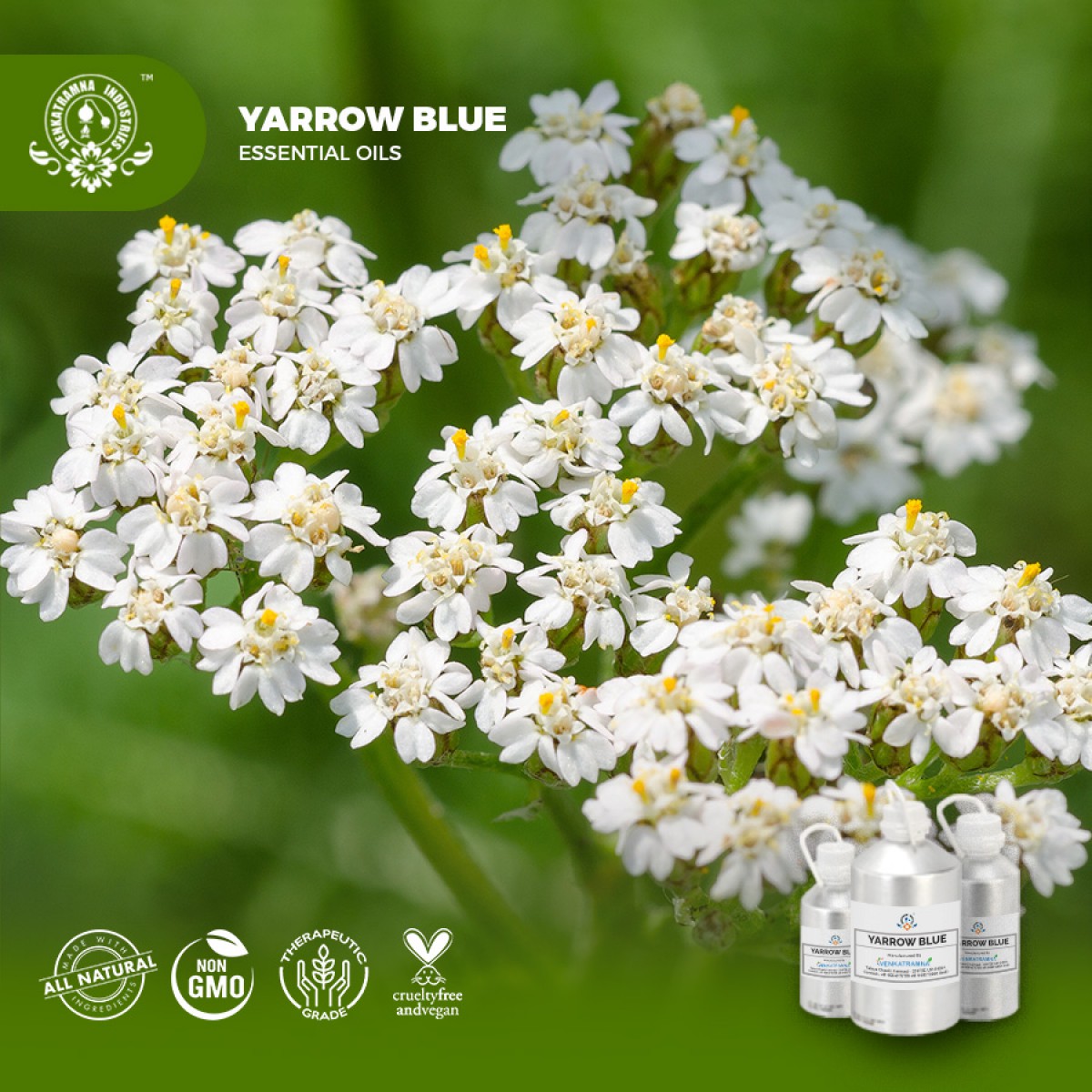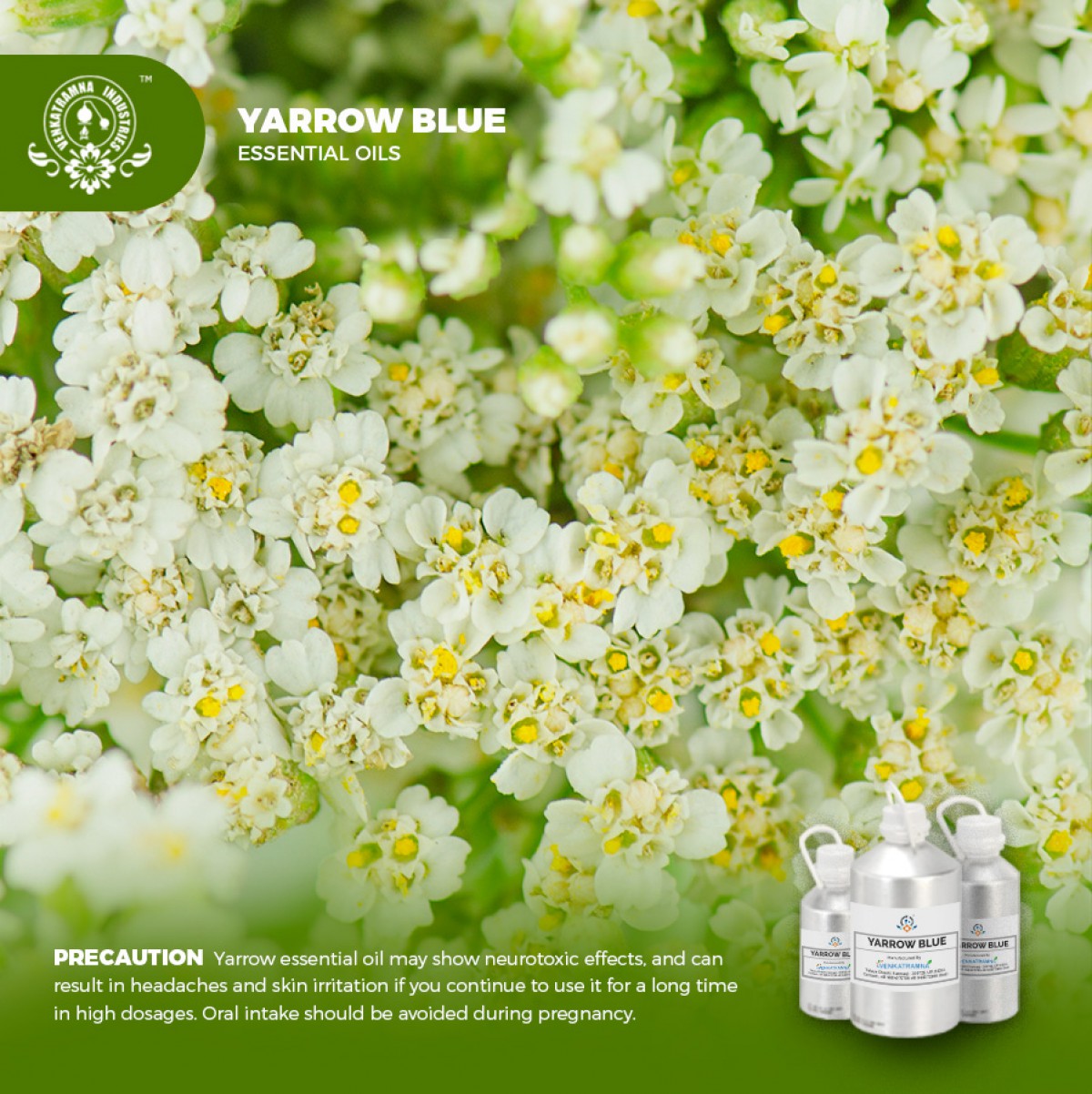Botanical Name: Achillea millefolium Common name: Common Yarrow Plant Read More
|
Botanical Name: |
Achillea millefolium |
|
Common name: |
Common Yarrow |
|
Plant family: |
Asteraceae |
|
Genus: |
Achillea |
|
Appearance/Color: |
A thin, clear, greenish to dark blue liquid. |
|
Odor: |
A top note with a medium aroma, Yarrow is sweet and herbaceous,
with spicy tones. |
|
Blends With: |
Angelica Root, Cedarwood, Pine, Myrrh, Frankincense and
Chamomile. |
|
Origin |
Hungary |
|
Source |
Aerial parts of flowering plant |
|
Method of
Extraction |
Steam Distillation |
Yarrow (Achillea millefolium) is a flowering plant in the family Asteraceae, it is called plumajillo, or "little feather", for the shape of the leaves. A wide range of chemical compounds have been isolated, mainlyisovaleric acid, salicylic acid, asparagin, sterols, flavonoids, bitters, tannins, and coumarins. Different parts of the plant have been used in traditional medicine as diaphoretic, astringent, tonic, stimulant and mild aromatic, cold and influenza, Amenorrhea, antiphlogistic. The aerial parts of the plant are used for phlegm conditions, as a bitter digestive tonic to encourage bile flow, and as a diuretic. The alkaloids extracted from the leaves of yarrow (Achillea millefolium) are reported to have anti-inflammatory and analgesic activity. yarrow (Achillea millefolium) shows several characteristic pharmacological effects like gastroprotective, Antibacterial, Antioxidant, Antiseptic, Expectorant, carminative activity which are consistent with the reported uses of the plant extracts in the indigenous system of medicine.
DISCLAIMER
The complete range of conditions
or methods of use are beyond our control therefore we do not assume any
responsibility and expressly disclaim any liability for any use of this
product. Information contained herein is believed to be true and accurate however,
all statements or suggestions are made without warranty, expressed or implied,
regarding accuracy of the information, the hazards connected with the use of
the material or the results to be obtained from the use thereof. Compliance
with all applicable federal, state, and local laws and local regulations
remains the responsibility of the user.
The FDA has not evaluated the
statements on this website. No claims are made by Venkatramna Industries as to
the medicinal value of any products from vriaroma.com or by us. The information
presented here is for educating our customers about the traditional uses of
essential oils and is not intended to diagnose, treat, cure, or prevent any
disease. You are responsible for understanding the safe application of these products.
If you have any questions, please call or email us for further information.
As per NAHA guidelines, New Directions Aromatics
(NDA) does not recommend the ingestion of essential oils. It is imperative to
consult a medical practitioner before using Essential Oils for therapeutic
purposes. Pregnant and nursing women and those taking prescription drugs are
especially advised not to use this product without the medical advice of a
physician. The oil should always be stored in an area that is inaccessible to
children, especially those under the age of 7.
Yarrow has a good reputation as
an anti-inflammatory and antiseptic and is widely used in herbal medicine. This
perennial wild edible tastes bitter but after all, bitter is generally better
for your health. Yarrow contains many vitamins and minerals and is used in the
treatment of a wide range of disorders. Yarrow is particularly valuable for
stopping the flow of blood, treating colds, fevers, treating wounds, kidney
diseases, menstrual pain, and much more. It also contains the anti-inflammatory
agent azulene, though the content of this varies even between plants in the
same habitat. Legend has it that Yarrow was named after Achilles, the Greek
mythical figure who used it to stop the bleeding wounds of his soldiers.
Yarrow was formerly used for
medicinal purposes: to break a fever by increasing perspiration, to treat
hemorrhaging and as a poultice for rashes. A tea used by Native Americans to
cure stomach disorders was made by steeping the leaves.
This aromatic wild edible grows
as a single, stout stem that produces tiny ray and disk flowers. Yarrow has
fern-like leaves. This perennial also produces attractive flower craniums that
possess white rays and have yellow, flat circular plates or discs inside them.
COMMON USAGE
·
Anti-inflammatory
·
Anti-rheumatic
·
Antiseptic
·
Anti-spasmodic
·
Astringent
·
Carminative
·
Cicatrisant
·
Diaphoretic
·
Digestion
·
Expectorant
·
Emenagohue
·
Emollient
·
Stomachic
·
Tranquilizing
·
Hemostatic
·
Hypotensive
Ingredients:
|
S.No |
Key Constituents |
Strength (%) |
|
1 |
Camphor |
13.7 |
|
2 |
Artemisia alcohol |
9.2 |
|
3 |
Germacrene D |
8.8 |
|
4 |
Artemisia ketone |
8.7 |
|
5 |
Viridiflorol |
5.7 |
|
6 |
Sabinyl acetate |
3.7 |
|
7 |
Borneol |
3.4 |
|
8 |
Bornyl acetate |
3.4 |
|
9 |
Terpinen-4-ol |
2.9 |
|
10 |
b-pinene |
2.7 |
|
11 |
camphene |
2.2 |
|
12 |
1,8-cineole |
1.9 |
|
13 |
g-terpinene |
1.7 |
|
14 |
Sabinol |
1.6 |
|
15 |
a-pinene |
1.3 |
|
16 |
Chrysanthenyl acetate |
1.0 |
Safety Summary
·
Hazards May be abortifacient.
·
Contraindications (all routes) Pregnancy,
breastfeeding.
Organ Specific Effects
·
Adverse skin reactions No information
found.
·
Reproductive toxicity No information
found. Sabinyl acetate is abortifacient in rodents at 15 mg/kg, and no safe
dose is known for this compound.
Systemic Effects
·
Acute toxicity No information found.
·
Antioxidant/pro-oxidant activity Green
yarrow oil demonstrates good DPPH radical scavenging activity.
·
Carcinogenic/anticarcinogenic potential
No information was found for green yarrow oil but it contains no known
carcinogens.
·
Info summery of Ecological Information Balance
of data on substance, not determined.
·
Eco toxicological properties of specific
substances
·
Toxicity Acute fish toxicity: LC50 / 96 HOUR –
No data available
·
Toxicity to aquatic plants – No data available
·
Toxicity to microorganisms – No data available
·
Toxicity threshold – No data available
·
Persistence and degradability Biodegradation is
expected
·
Bio-accumulative potential Bioaccumulation is
unlikely
·
Mobility in soil Unknown
·
Other adverse effect Avoid exposure to marine
environments and waterways





 MSDS-Yarrow.pdf
MSDS-Yarrow.pdf




